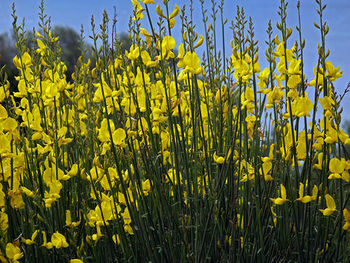Spanish broom
From Wikiwel
Other Names : Spartium junceum, Broom , Genet, Genet Absolute
The Spanish Broom is a shrub which belongs to the Fabaceae family. It originated from southern Europe, northwest Africa and south Asia. It grows well in sunny weather and can thrive on the dry and sandy soils as well. The flowers grow on a deciduous bush known as the S.Junceum, this particular shrub grows no taller than 5 meters in height. It has small pea sized yellow sweet smelling flowers which are just 1 to 2 cm in diameter.
Special Precautions of Spanish broom
- In high doses, this plant becomes very toxic by diminishing the pulse rate to such low levels that it can become lethal, so it is not advised to use this plant to prepare home-made remedies. Symptoms of poisoning with Spanish broom can cary depending of the ingested amount: Vomiting, diarrhea, tachycardia, somnolence, painful breathing, lowering of hearth pulse and death.
- Contains Alkaloids: The whole plant (cytisine, sparteine), but specially the flowers and seeds. The flowers are very rich in scoparin and genistein is mainly found in young shoots. Mainly cytisine and sparteine together with genistein and isosparteine
- Cytisine becomes hallucinogen and stimulant of the respiratory track. It is highly toxic, resulting lethal in a superior dose of 5 mg. Other plants where this component can be found are: Ulex europaeus or Genista tinctoria.
- Sparteine contains abortive, antiarrhythmic, cardiodepressive, diuretic and hypoglycemic properties. Consequently, it exerts a relaxing function in cardiac muscle although it can be considered very poisonous. It is even used as insecticide. It appears in less proportion in other plants as Cytisus scoparius and Aconitus napelus, the last one being considered one of the highest poisons in the world.
- In a lower dose, genistein can also result abortive, fungicide and anticancerous.
- Should not be confused with Cytisus scoparius, Scotch broom, and commonly also named Broom.
Health benefits and Uses of Spanish broom
- Spanish broom has been used as diuretic and laxative. Diuresis or water elimination of the body is produced by the action of scoparin on the renal mucosa.
- Sparteine is used as a heart tonic, although the quantity of this product contained in the plant is so high, that Cytisus scoparius, with a lesser content, is being used instead.
- Antidote against vipers. In some places in Africa the decoction of the peeled branches is used to counteract viper bites.
- Spanish broom absolute (Genet Absolute) (Aromatherapy) : Only External Use.
- as an anti depressant : It's helpfull for people suffering from chronic depression. It keeps all sort of negative and depressing thoughts at bay and promotes peace of mind and a general feeling of well being.
- As a disinfectant
- Possible skin care benefits. In a scholarly study (In vitro tyrosinase inhibitory and antioxidant potential of Consolida orientalis, Onosma isauricum and Spartium junceum) published January 2018, "...S. junceum was investigated as a tyrosinase inhibitor for the management of epidermal hyperpigmentation. S. junceum showed promising activity that warrant further studies and could be considered as a potent candidate for the development of phytoremedies for the management of epidermal hyperpigmentation."
- massage : it helps loosen tight muscles and gives complete relaxation.
